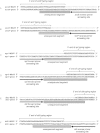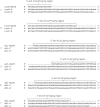Effectiveness of the standard and an alternative set of Streptococcus pneumoniae multi locus sequence typing primers
- PMID: 24889110
- PMCID: PMC4057806
- DOI: 10.1186/1471-2180-14-143
Effectiveness of the standard and an alternative set of Streptococcus pneumoniae multi locus sequence typing primers
Abstract
Background: Multi-locus sequence typing (MLST) is a portable, broadly applicable method for classifying bacterial isolates at an intra-species level. This methodology provides clinical and scientific investigators with a standardized means of monitoring evolution within bacterial populations. MLST uses the DNA sequences from a set of genes such that each unique combination of sequences defines an isolate's sequence type. In order to reliably determine the sequence of a typing gene, matching sequence reads for both strands of the gene must be obtained. This study assesses the ability of both the standard, and an alternative set of, Streptococcus pneumoniae MLST primers to completely sequence, in both directions, the required typing alleles.
Results: The results demonstrated that for five (aroE, recP, spi, xpt, ddl) of the seven S. pneumoniae typing alleles, the standard primers were unable to obtain the complete forward and reverse sequences. This is due to the standard primers annealing too closely to the target regions, and current sequencing technology failing to sequence the bases that are too close to the primer. The alternative primer set described here, which includes a combination of primers proposed by the CDC and several designed as part of this study, addresses this limitation by annealing to highly conserved segments further from the target region. This primer set was subsequently employed to sequence type 105 S. pneumoniae isolates collected by the Canadian Immunization Monitoring Program ACTive (IMPACT) over a period of 18 years.
Conclusions: The inability of several of the standard S. pneumoniae MLST primers to fully sequence the required region was consistently observed and is the result of a shift in sequencing technology occurring after the original primers were designed. The results presented here introduce clear documentation describing this phenomenon into the literature, and provide additional guidance, through the introduction of a widely validated set of alternative primers, to research groups seeking to undertake S. pneumoniae MLST based studies.
Figures


Similar articles
-
Multilocus sequence typing of Streptococcus pneumoniae by use of mass spectrometry.J Clin Microbiol. 2011 Nov;49(11):3756-60. doi: 10.1128/JCM.05113-11. Epub 2011 Aug 31. J Clin Microbiol. 2011. PMID: 21880964 Free PMC article.
-
Serological and molecular capsular typing, antibiotic susceptibility and multilocus sequence typing of Streptococcus pneumoniae isolates from invasive and non-invasive infections.Chin Med J (Engl). 2013 Jun;126(12):2296-303. Chin Med J (Engl). 2013. PMID: 23786942
-
Multiple-locus variable-number tandem-repeat analysis of Streptococcus pneumoniae and comparison with multiple loci sequence typing.BMC Microbiol. 2012 Oct 22;12:241. doi: 10.1186/1471-2180-12-241. BMC Microbiol. 2012. PMID: 23088225 Free PMC article.
-
An extended multi-locus molecular typing schema for Streptococcus pneumoniae demonstrates that a limited number of capsular switch events is responsible for serotype heterogeneity of closely related strains from different countries.Infect Genet Evol. 2013 Jan;13:151-61. doi: 10.1016/j.meegid.2012.09.008. Epub 2012 Sep 27. Infect Genet Evol. 2013. PMID: 23022733
-
Current challenges in the accurate identification of Streptococcus pneumoniae and its serogroups/serotypes in the vaccine era.J Microbiol Methods. 2017 Oct;141:48-54. doi: 10.1016/j.mimet.2017.07.015. Epub 2017 Aug 2. J Microbiol Methods. 2017. PMID: 28780272 Review.
Cited by
-
A generic workflow for Single Locus Sequence Typing (SLST) design and subspecies characterization of microbiota.Sci Rep. 2019 Dec 27;9(1):19834. doi: 10.1038/s41598-019-56065-y. Sci Rep. 2019. PMID: 31882601 Free PMC article.
-
Long-Term Epidemiology of Streptococcus pneumoniae Serogroup 6 in a Region of Southern Europe with Special Reference to Serotype 6E.PLoS One. 2016 Feb 10;11(2):e0149047. doi: 10.1371/journal.pone.0149047. eCollection 2016. PLoS One. 2016. PMID: 26863305 Free PMC article.
-
Characterization of Streptococcus pneumoniae isolates from Austrian companion animals and horses.Acta Vet Scand. 2017 Nov 14;59(1):79. doi: 10.1186/s13028-017-0348-2. Acta Vet Scand. 2017. PMID: 29137652 Free PMC article.
-
Determination of Characteristics of Erythromycin Resistant Streptococcus pneumoniae with Preferred PCV Usage in Iran.PLoS One. 2016 Dec 29;11(12):e0167803. doi: 10.1371/journal.pone.0167803. eCollection 2016. PLoS One. 2016. PMID: 28033345 Free PMC article.
-
Serotype Distribution and Multi Locus Sequence Type (MLST) of Erythromycin-Resistant Streptococcus Pneumoniae Isolates in Tehran, Iran.Rep Biochem Mol Biol. 2023 Jul;12(2):259-268. doi: 10.61186/rbmb.12.2.259. Rep Biochem Mol Biol. 2023. PMID: 38317819 Free PMC article.
References
-
- Maiden MC, Bygraves JA, Feil E, Morelli G, Russell JE, Urwin R, Zhang Q, Zhou J, Zurth K, Caugant DA, Feavers IM, Achtman M, Spratt BG. Multilocus sequence typing: a portable approach to the identification of clones within populations of pathogenic microorganisms. Proc Natl Acad Sci U S A. 1998;95(6):3140–3145. doi: 10.1073/pnas.95.6.3140. - DOI - PMC - PubMed
-
- Bentley SD, Aanensen DM, Mavroidi A, Saunders D, Rabbinowitsch E, Collins M, Donohoe K, Harris D, Murphy L, Quail MA, Samuel G, Skovsted IC, Kaltoft MS, Barrell B, Reeves PR, Parkhill J, Spratt BG. Genetic analysis of the capsular biosynthetic locus from All 90 pneumococcal serotypes. PLoS Genet. 2006;2(3):e31. doi: 10.1371/journal.pgen.0020031. - DOI - PMC - PubMed
-
- Satzke C, Turner P, Virolainen-Julkunen A, Adrian PV, Antonio M, Hare KM, Henao-Restrepo AM, Leach AJ, Klugman KP, Porter BD, Sá-Leão R, Scott JA, Nohynek H, O’Brien KL. Standard method for detecting upper respiratory carriage of Streptococcus pneumoniae: Updated recommendations from the World Health Organization Pneumococcal Carriage Working Group. Vaccine. 2013;32(1):165–179. doi: 10.1016/j.vaccine.2013.08.062. - DOI - PubMed
Publication types
MeSH terms
Substances
LinkOut - more resources
Full Text Sources
Other Literature Sources

